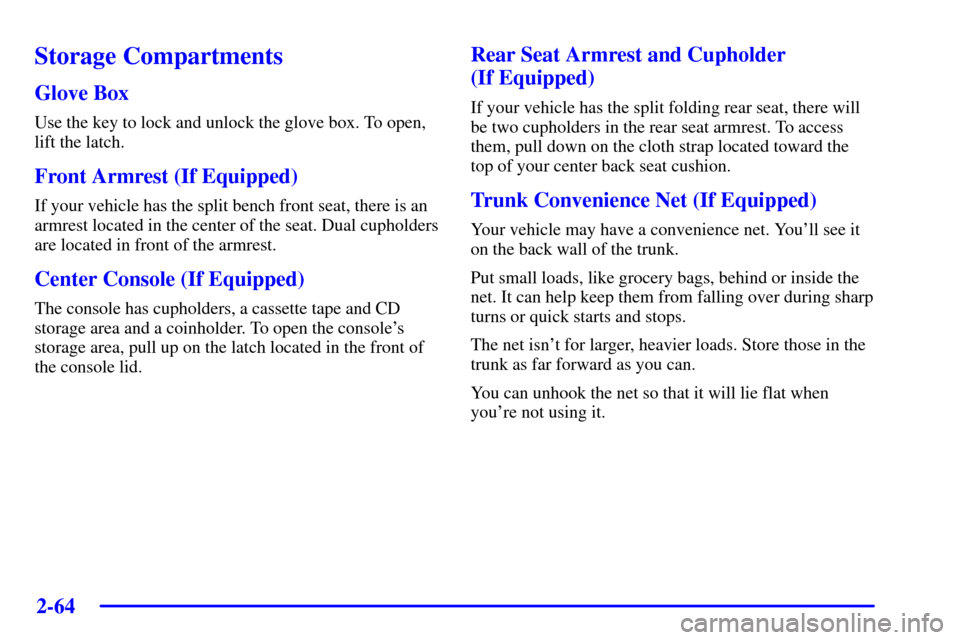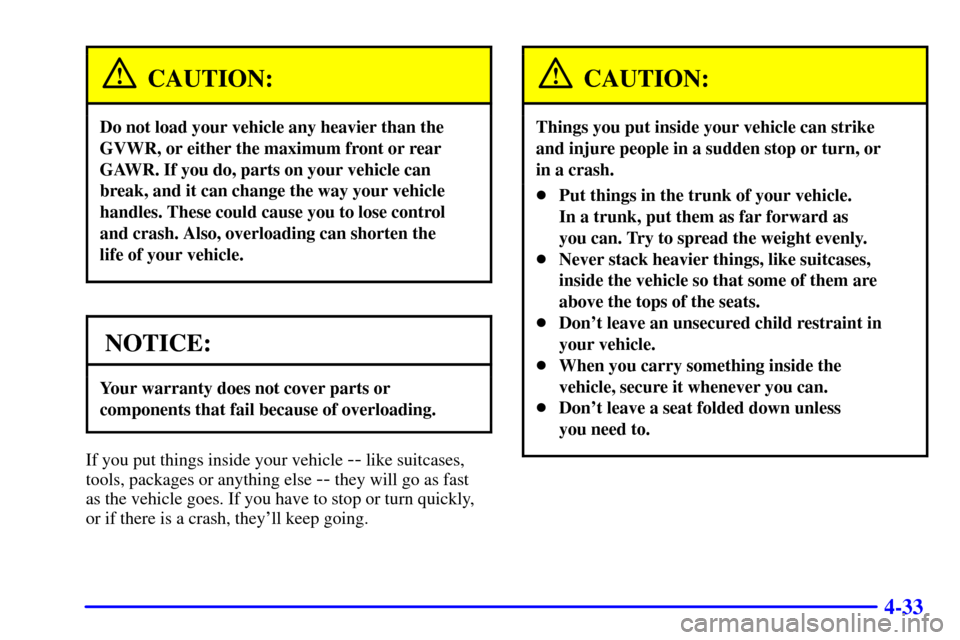Page 130 of 397

2-64
Storage Compartments
Glove Box
Use the key to lock and unlock the glove box. To open,
lift the latch.
Front Armrest (If Equipped)
If your vehicle has the split bench front seat, there is an
armrest located in the center of the seat. Dual cupholders
are located in front of the armrest.
Center Console (If Equipped)
The console has cupholders, a cassette tape and CD
storage area and a coinholder. To open the console's
storage area, pull up on the latch located in the front of
the console lid.
Rear Seat Armrest and Cupholder
(If Equipped)
If your vehicle has the split folding rear seat, there will
be two cupholders in the rear seat armrest. To access
them, pull down on the cloth strap located toward the
top of your center back seat cushion.
Trunk Convenience Net (If Equipped)
Your vehicle may have a convenience net. You'll see it
on the back wall of the trunk.
Put small loads, like grocery bags, behind or inside the
net. It can help keep them from falling over during sharp
turns or quick starts and stops.
The net isn't for larger, heavier loads. Store those in the
trunk as far forward as you can.
You can unhook the net so that it will lie flat when
you're not using it.
Page 145 of 397
2-79
The main components of your instrument panel are listed here:
A. Instrument Panel Fuse Block
B. Traction Control On/Off Button (If Equipped)
C. Multifunction Lever
D. Audio Steering Wheel Controls (Option)
E. Hazard Warning Flasher Button
F. Audio System
G. Air Vent
H. Exterior Lamps ControlI. Remote Trunk Release Button
J. Tilt Steering Wheel Lever
K. Hood Release
L. Steering Wheel Cruise Control (If Equipped)
M. Ignition Switch
N. Center Console Shift Lever (If Equipped)
O. Climate Controls
P. Glove Box
Page 167 of 397
2-101
Low Tire Pressure (If Equipped)
United States Canada
The low tire pressure system monitors the inflation
pressure of the tires.
After the system has learned tire pressure with properly
inflated tires, the LOW TIRE PRESSURE message will
be displayed and four warning chimes will sound if the
tire pressure in one tire becomes 12 psi (83 kPa) lower
than the other three tires.
When you have checked the tire pressures, be sure to
reset the tire inflation monitor. See ªTiresº in the Index.Service Vehicle SoonUnited States Canada
This message will come on if you have engine problems.
These problems may not be obvious and may not
affect vehicle performance or durability. Consult a
qualified dealership for necessary repairs to maintain
top vehicle performance.
This message may also appear if there are electrical
problems with the trunk release sensor. See ªTrunk
Release Sensorº in the Index for more information.
Page 168 of 397
2-102
Trunk Open
United States Canada
This message will appear if the trunk is not completely
closed and the ignition is in ON.
If you are in a forward or reverse gear position you will
also hear four chimes.
If this message flashes for one minute after the
ignition is turned on, the trunk release sensor is
turned off. See ªTrunk Release Sensorº in the
Index for more information.Highbeam Out United States Canada
If this message appears, you may have a problem with
your high
-beam headlamps.
The message will stay on approximately 60 seconds.
When the ignition is turned off, this message will be
displayed again for three seconds to remind you that you
may have a problem with your highbeam
-headlamps.
Be sure to check your bulbs right away and replace them
if necessary.
See ªBulb Replacementº in the Index.
Page 238 of 397
4-26
Winter Driving
Here are some tips for winter driving:
�Have your vehicle in good shape for winter.
�You may want to put winter emergency supplies in
your trunk.
Include an ice scraper, a small brush or broom, a supply
of windshield washer fluid, a rag, some winter outer
clothing, a small shovel, a flashlight, a red cloth and a
couple of reflective warning triangles. And, if you will
be driving under severe conditions, include a small bag
of sand, a piece of old carpet or a couple of burlap bags
to help provide traction. Be sure you properly secure
these items in your vehicle.
Page 244 of 397

4-32
Loading Your Vehicle
Two labels on your vehicle show how much weight it
may properly carry. The Tire
-Loading Information label
is on the inside of the trunk lid. The label tells you the
proper size, speed rating and recommended inflation
pressures for the tires on your vehicle. It also gives you
important information about the number of people that
can be in your vehicle and the total weight you can
carry. This weight is called the vehicle capacity weight
and includes the weight of all occupants, cargo and all
nonfactory
-installed options.
The other label is the Certification label, found on the
rear edge of the driver's door. It tells you the gross
weight capacity of your vehicle, called the Gross
Vehicle Weight Rating (GVWR). The GVWR includes
the weight of the vehicle, all occupants, fuel and cargo.
Never exceed the GVWR for your vehicle or the Gross
Axle Weight Rating (GAWR) for either the front or
rear axle.
If you do have a heavy load, spread it out. Don't carry
more than 167 pounds (75 kg) in your trunk.
Page 245 of 397

4-33
CAUTION:
Do not load your vehicle any heavier than the
GVWR, or either the maximum front or rear
GAWR. If you do, parts on your vehicle can
break, and it can change the way your vehicle
handles. These could cause you to lose control
and crash. Also, overloading can shorten the
life of your vehicle.
NOTICE:
Your warranty does not cover parts or
components that fail because of overloading.
If you put things inside your vehicle -- like suitcases,
tools, packages or anything else
-- they will go as fast
as the vehicle goes. If you have to stop or turn quickly,
or if there is a crash, they'll keep going.
CAUTION:
Things you put inside your vehicle can strike
and injure people in a sudden stop or turn, or
in a crash.
�Put things in the trunk of your vehicle.
In a trunk, put them as far forward as
you can. Try to spread the weight evenly.
�Never stack heavier things, like suitcases,
inside the vehicle so that some of them are
above the tops of the seats.
�Don't leave an unsecured child restraint in
your vehicle.
�When you carry something inside the
vehicle, secure it whenever you can.
�Don't leave a seat folded down unless
you need to.
Page 249 of 397

4-37 Total Weight on Your Vehicle's Tires
Be sure your vehicle's tires are inflated to the upper
limit for cold tires. You'll find these numbers on the Tire
Loading
-Information label, located on the inside of the
trunk lid, or see ªLoading Your Vehicleº in the Index.
Then be sure you don't go over the GVW limit for your
vehicle, including the weight of the trailer tongue.
Hitches
It's important to have the correct hitch equipment.
Crosswinds, large trucks going by and rough roads are a
few reasons why you'll need the right hitch. Here are
some rules to follow:
�The rear bumper on your vehicle is not intended
for hitches. Do not attach rental hitches or other
bumper
-type hitches to it. Use only a frame-mounted
hitch that does not attach to the bumper.�Will you have to make any holes in the body of
your vehicle when you install a trailer hitch? If you
do, then be sure to seal the holes later when you
remove the hitch. If you don't seal them, deadly
carbon monoxide (CO) from your exhaust can get
into your vehicle. See ªCarbon Monoxideº in the
Index. Dirt and water can, too.
Safety Chains
You should always attach chains between your vehicle
and your trailer. Cross the safety chains under the tongue
of the trailer so that the tongue will not drop to the road
if it becomes separated from the hitch. Instructions
about safety chains may be provided by the hitch
manufacturer or by the trailer manufacturer. Follow the
manufacturer's recommendation for attaching safety
chains and do not attach them to the bumper. Always
leave just enough slack so you can turn with your rig.
And, never allow safety chains to drag on the ground.